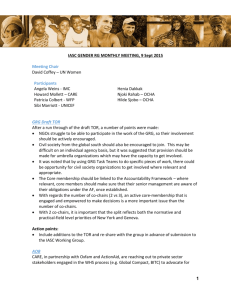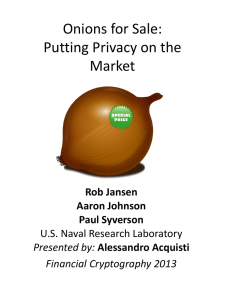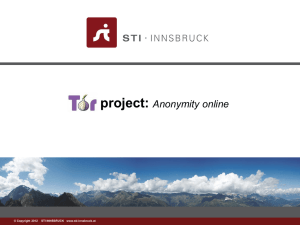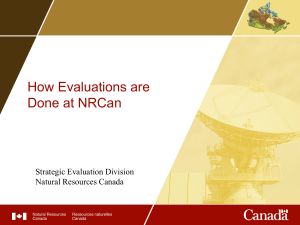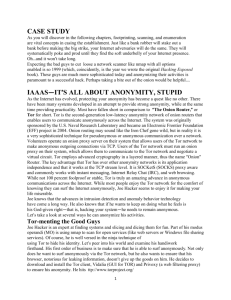S017-Submission
advertisement
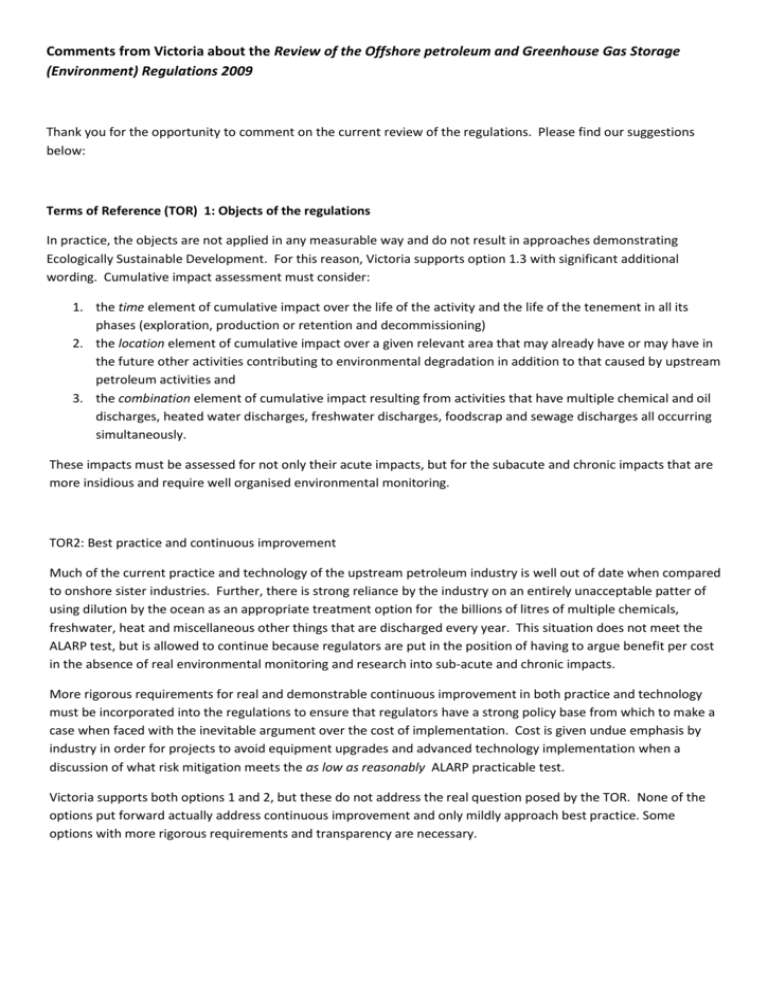
Comments from Victoria about the Review of the Offshore petroleum and Greenhouse Gas Storage (Environment) Regulations 2009 Thank you for the opportunity to comment on the current review of the regulations. Please find our suggestions below: Terms of Reference (TOR) 1: Objects of the regulations In practice, the objects are not applied in any measurable way and do not result in approaches demonstrating Ecologically Sustainable Development. For this reason, Victoria supports option 1.3 with significant additional wording. Cumulative impact assessment must consider: 1. the time element of cumulative impact over the life of the activity and the life of the tenement in all its phases (exploration, production or retention and decommissioning) 2. the location element of cumulative impact over a given relevant area that may already have or may have in the future other activities contributing to environmental degradation in addition to that caused by upstream petroleum activities and 3. the combination element of cumulative impact resulting from activities that have multiple chemical and oil discharges, heated water discharges, freshwater discharges, foodscrap and sewage discharges all occurring simultaneously. These impacts must be assessed for not only their acute impacts, but for the subacute and chronic impacts that are more insidious and require well organised environmental monitoring. TOR2: Best practice and continuous improvement Much of the current practice and technology of the upstream petroleum industry is well out of date when compared to onshore sister industries. Further, there is strong reliance by the industry on an entirely unacceptable patter of using dilution by the ocean as an appropriate treatment option for the billions of litres of multiple chemicals, freshwater, heat and miscellaneous other things that are discharged every year. This situation does not meet the ALARP test, but is allowed to continue because regulators are put in the position of having to argue benefit per cost in the absence of real environmental monitoring and research into sub-acute and chronic impacts. More rigorous requirements for real and demonstrable continuous improvement in both practice and technology must be incorporated into the regulations to ensure that regulators have a strong policy base from which to make a case when faced with the inevitable argument over the cost of implementation. Cost is given undue emphasis by industry in order for projects to avoid equipment upgrades and advanced technology implementation when a discussion of what risk mitigation meets the as low as reasonably ALARP practicable test. Victoria supports both options 1 and 2, but these do not address the real question posed by the TOR. None of the options put forward actually address continuous improvement and only mildly approach best practice. Some options with more rigorous requirements and transparency are necessary. TOR 3 and 5: Consultation and notification – representation of interest groups and stakeholders These two terms of reference must be addressed together. According to the Act. There is not requirement to consult with other stakeholders and users of the ocean prior to the allocation of acreage and issuing of tenements in the offshore area . While it is true that this may happen as a courtesy, without a requirement to undertake appropriate consultation and a further requirement to consider the results of the consultation, there are numerous case studies in which other ocean users have been significantly impacted without any consultation and recourse. Additionally, because the consultation associated with these regulations happens post the conferral of rights, consultation is really only notification. When a conflict arises, other ocean users and stakeholders lack to sophistication of understanding about the upstream petroleum industry and government processes to adequately negotiate for their rights. The Act is also disproportionately punishing on interference with petroleum activities when compared to petroleum activities interfering with other users. In the case of terrorism and the like, this is understandable, but in the case of fishers or recreation boaters, this is out of balance. None of the options provided in TOR 3 actually address the effectiveness of consultation. Option 3.5 is supported for notification purposes, but significantly more review is required to find some options for effective consultation. Option 5.1 is supported with the addition of compulsory consultation and consideration of results at the acreage release and tenement issuing stages of petroleum activities. TOR 4: Reporting arrangements Victoria supports the review assessment of this TOR and agrees with a combination of the options 4.3, 4.4 and 4.5. TOR 6: Duties and responsibilities Victoria fully supports the review assessment of this TOR and agrees with option 6.2. TOR 7: Transparency of current arrangements and publication of information Victoria supports the review assessment of this TOR and agrees with a combination of the options 7.2, 7.3, 7.5 and 7.6. TOR 8: Effectiveness and completeness of Oil Spill Contingency Plan (OSCP) Victoria supports the review assessment of this TOR and agrees with a combination of the options 8.5, 8.6, 8.7, 8.8 8.9 and 8.12. TOR 9: Alignment of Terminology Victoria supports the review assessment of this TOR and agrees with a combination of the options 9.3 and 9.4. TOR 10: The effectiveness and completeness of monitoring provisions The options provided do not offer a real change to the current regime that only requires operational monitoring. Operational monitoring is not evidence that the risk management measures have been successful or not. This situation is also decades out of step with inshore and onshore sister industries that must have environmental evidence of compliance, not just operational evidence. As regulators we constantly find non-compliances with the operational requirements of the EP during audits and inspections. The impacts of these non-compliances on the environment are never measured or reported. Only real time environmental monitoring can demonstrate, as evidence, that the operational practices, procedures, technology and equipment are meeting the ALARP test. Environmental monitoring must include assessment of subacute and chronic impacts as well as acute impacts in order to be credible and for completeness. Victoria supports option 10.4, but it must be augmented as outlined above to appropriately address the whole issue. TOR 11: Decisions across the offshore petroleum development life Victoria supports the review assessment of this TOR and agrees with option 11.1. TOR: 12: Effectiveness of compliance and enforcement framework, including penalties Compliance and enforcement work of regulators relies on the limited access to petroleum facilities and activities entirely controlled by the tenement holders. This inefficiency has not been dealt with in this section, but is worth noting. Victoria supports the review assessment of this TOR and agrees with the implementation of the points i, ii, and iii made in the body of the review. Point ii addressing additional lower level legislative tools is absolutely necessary and the absence of these is decades out of date with inshore and onshore sister industry legislation. Also, this would allow a “pyramid” model of enforcement policy to be implemented, consistent with objective legislation in Australia and around the world. That is, a large set of tools in the advice and guidance category at the bottom used frequently, some mid- level tools with mid-level penalties in the middle to be used occasionally and prosecution and tenement cancelation at the peak of the pyramid to be used rarely. It is not clear that this would be an outcome of the options offered. On the bases that this would be the result, Victoria supports option 12.1. TOR 13: Other changes Victoria believes that the objective of this TOR is well meaning , but the option needs more work. The option offered takes away a great deal of certainty for community and stakeholders about opportunities for input to particular aspects of petroleum activity, appropriate assessment of issues each time an activity is proposed that will consider emerging and new information and a loss of independent assessment for particular aspects from organisations that are also vested with business development responsibilities in the industry. TOR 14: Any other matters Not addressed at this time.

